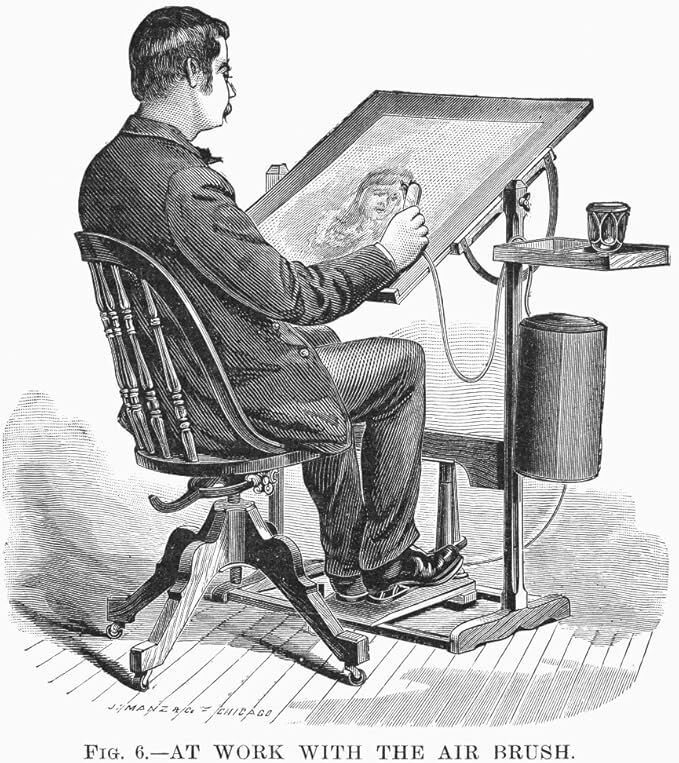Airbrush art evolution spans centuries, reflecting technological advancements and shifts in artistic trends. This article takes you on a journey through the history of airbrush art, from its ancient origins to the modern masterpieces that inspire awe today.

Ancient Beginnings of Airbrush Art Evolution
Airbrush art traces its roots back to prehistoric times. Early humans used rudimentary tools to blow pigments onto cave walls, creating murals that depicted their daily lives. Notably, the famous cave paintings in Lascaux, France, showcase early airbrushing techniques. Artists used hollow bones to blow pigments, forming images of animals and hunting scenes.
These early artists relied on natural materials like charcoal, ochre, and iron oxides. Mixing these with saliva or water, they created the first airbrush paints. This method allowed them to produce soft lines and dynamic compositions, conveying both movement and depth.
In addition, ancient civilizations—including the Egyptians, Greeks, and Romans—used primitive airbrush-like methods. They employed blowpipes or reeds to apply color when decorating pottery and frescoes. These techniques helped achieve gradients and shading, adding depth to their artwork. For example, Egyptian tomb paintings and Roman mosaics often featured intricate airbrushed effects. As a result, these early techniques laid the foundation for future artistic innovations.

The Birth of Modern Airbrushing
The modern airbrush began to take shape in the late 19th century. In 1879, Abner Peeler invented the first airbrush device, calling it the “paint distributor.” This early tool set the stage for more advanced airbrushes developed in later decades.
Peeler’s invention used a basic mechanism to atomize paint, offering smoother application than traditional brushes. Eventually, artists and inventors refined the tool, leading to the creation of double-action airbrushes in the early 20th century. These advanced airbrushes allowed users to control airflow and paint flow simultaneously, offering greater precision.
As a result, double-action airbrushes became popular among illustrators and commercial artists. They were widely used in advertisements, magazine covers, and product packaging. Companies like Thayer and Chandler played a significant role in marketing airbrushes, making them accessible to a broader audience.

Airbrush Art in the 20th Century
The mid-20th century marked the golden age of airbrush illustration. Artists like Alberto Vargas became famous for airbrushed pin-up art and magazine illustrations. The airbrush’s ability to create smooth gradients and lifelike textures made it ideal for achieving realism in commercial art.
During this time, airbrush art wasn’t limited to magazines. It found its way into custom car designs, known as “kustom kulture,” thanks to artists like Ed “Big Daddy” Roth and Von Dutch. Additionally, airbrush art became a staple in music culture, with album covers and concert posters featuring bold designs.
In the 1960s and 1970s, airbrush art exploded in popularity within pop culture. Custom car enthusiasts used airbrushes to create intricate designs and vibrant graphics on vehicles, leading to the rise of “kustom kulture.” Artists like Ed “Big Daddy” Roth and Von Dutch became legends in the custom car scene, using airbrush techniques to transform cars and motorcycles into mobile works of art. Airbrushing also found its way into fashion, with artists customizing clothing, helmets, and even body art. The airbrush became a symbol of individuality and creativity, allowing people to express their personalities through unique, personalized designs. This era also saw the rise of airbrush art in music, with album covers, concert posters, and stage backdrops featuring bold, airbrushed imagery.

The Boom of the 1980s and 1990s
In the 1980s and 1990s, airbrush art exploded in popularity, particularly on beach boardwalks. Artists set up stalls and shops, offering tourists personalized apparel like T-shirts and hats. These custom designs featured names, slogans, and vibrant beach-themed imagery.
The appeal of airbrushing lay in its immediacy and customizability. Tourists loved taking home unique souvenirs that captured the spirit of their vacation. Moreover, airbrush fairs and expos during this period fostered a sense of community among artists, encouraging the exchange of techniques and ideas.
This era also saw the rise of “airbrush fairs” and “airbrush expos,” where artists would showcase their skills, compete in live painting contests, and share techniques. These events helped to build a sense of community among airbrush artists and enthusiasts, fostering the exchange of ideas and innovations.

The Digital Age and Contemporary Airbrush Art
The rise of digital technology in the late 20th century opened new doors for airbrush artists. Digital tools like Adobe Photoshop and Corel Painter allowed artists to create airbrush-like effects on computers. Consequently, digital airbrushing expanded the medium’s versatility, enabling faster production of intricate designs.
Today, airbrush art continues to evolve. Many contemporary artists push boundaries by blending traditional and digital methods. Artists like Dru Blair and Marissa Oosterlee have gained international recognition for their exceptional work, demonstrating the limitless potential of airbrush art.
Furthermore, airbrush art now extends beyond traditional canvases. Artists create murals, installations, and even virtual reality experiences. This ongoing innovation keeps airbrush art relevant and exciting.
Conclusion
The evolution of airbrush art is a testament to human ingenuity and creativity. From prehistoric cave paintings to cutting-edge digital designs, airbrush art has continually adapted to new technologies and trends. As artists continue to innovate, the future of airbrush art promises even more stunning masterpieces.
Whether you’re an aspiring artist or an enthusiast, the history of airbrush art offers endless inspiration. Its rich legacy reminds us that the desire to create beauty transcends time, tools, and techniques.
